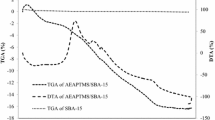Abstract
Poly(methyl methacrylate) (PMMA) was synthesized via activators regenerated by electron transfer (ARGET) in atom transfer radical polymerization (ATRP) (ARGET ATRP) of methyl methacrylate in N,N-dimethylformamide and using ethyl 2-bromoisobutyrate as initiator, CuCl2 as catalyst, N,N,N′,N′-tetramethylethylene-diamine as ligand and ethanol as a reducing agent. The polymerization temperature was kept at 70 °C. A well-defined PMMA with predetermined molecular weight and narrow molecular weight distribution was obtained. A linear relationship between ln([M]0/[M]) and polymerization time was found to show the living and controllable radical polymerization. The molecular weights of the obtained polymers increased linearly with monomer conversion and the data are in good agreement with the theoretical values with narrow molecular weight distribution (M w/M n). That is to say, alcohols were found to be a kind of highly efficient agents in the presence of Na2CO3 in this system. The effects of temperature, different types of alcohols and the amount of n-propanol on the polymerization were investigated. With increasing temperature (changed from 70 to 90 °C) and the amount of n-propanol (changed from 500:1:1:2:1:2 to 500:1:1:2:10:2), the conversion increased from 15.6 to 34.7 % and from 8.6 to 26.8 %, respectively. However, the value of M w/M n became broader when the molar ratio of [MMA]0/[EBiB]0/[CuCl2]0/[TMEDA]0/[n-propanol]0/[Na2CO3]0 was 500:1:1:2:1:2, indicating that the amount of n-propanol played an important role in ARGET ATRP of MMA. The activation energy was calculated to be 51.96 kJ/mol. The different types of alcohol were demonstrated to be an efficient reducing agent in this system except for tert-butyl alcohol. The “living” feature of the obtained polymer was further verified by a chain extension experiment. The obtained polymer was characterized by 1H NMR and GPC.






Similar content being viewed by others
References
Matyjaszewski K, Tsarevsky NV (2009) Nanostructured functional materials prepared by atom transfer radical polymerization. Nature Chem 1:276–288
Tsarevsky NV, Matyjaszewski K (2007) “Green” atom transfer radical polymerization: from process design to preparation of well-defined environmentally friendly polymeric materials. Chem Rev 107:2270–2299
Matyjaszewski K, Spanswick J (2005) Controlled/living radical polymerization. Mater Today 8:26–33
Wang GX, Wu H (2011) Microwave-assisted controlled copolymerization of styrene and acrylonitrile catalyzed by FeCl3/isophthalic acid. Polym Bull 67:1809–1821
Wang GX, Lu M, Hou ZH, Wu H (2013) Reactivity ratios of controlled/living copolymerization of styrene and acrylonitrile in ionic liquid microemulsion. J Polym Res 20:80–85
Wang GX (2011) Synthesis of poly(n-butyl acrylate) homopolymers by activators generated by electron transfer (AGET) ATRP using FeCl3·6H2O/succinic acid catalyst. Iran Polym J 20:931–938
Wang GX, Lu M, Wu H (2012) Preparation of poly(methyl methacrylate) by ATRP using initiators for continuous activator regeneration (ICAR) in ionic liquid/microemulsions. Polymer 53:1093–1097
Wang GX, Lu M, Liu Y (2012) ICAR ATRP of methyl methacrylate catalyzed by FeCl3·6H2O/succinic acid. J Appl Polym Sci 126:381–386
Wang GX, Lu M, Liu LC, Wu H, Zhong M (2013) Fe-Mediated ARGET atom transfer radical polymerization of methyl methacrylate in ionic liquid-based microemulsion. J Appl Polym Sci 128:3077–3083
Wang GX, Lu M (2012) ARGET ATRP of copolymerization of styrene and acrylonitrile with environmentally friendly catalyst and ligand. e-Polymers 054
Wang GX, Lu M (2012) Fe-mediated SET-LRP of MMA and St in the presence of air. Polym Int 61:1279–1283
Wang GX (2012) Copolymerization of styrene and methyl methacrylate mediated by copper (0)/2,2′-bipyridine in the presence and absence of phenol. J Macromol Sci Part A Pure Appl Chem 49:55–59
Wang GX, Lu M, Li J, Liu LC, Luo BP, Wu H, Zhong M (2013) Copolymerization of styrene and methyl methacrylate mediated by iron wire/N, N, N/, N/-tetramethyl-1,2-ethanediamine as catalyst in the presence of air. Iran Polym J 22:109–116
Gnanou Y, Hiza G (2004) Effect of phenol and derivatives on atom transfer radical polymerization in the presence of air. J Polym Sci, Part A: Polym Chem 42:351–359
Jakubowski W, Min K, Matyjaszewski K (2006) Activators regenerated by electron transfer for atom transfer radical polymerization of styrene. Macromolecules 39:39–45
Min K, Gao H, Matyjaszewski K (2007) Use of ascorbic acid as reducing agent for synthesis of well-defined polymers by ARGET ATRP. Macromolecules 40:1789–1791
Matyjaszewski K, Dong H, Jakubowski W, Pietrasik J, Kusumo A (2007) Grafting from surfaces for “everyone”: ARGET ATRP in the presence of air. Langmuir 23:4528–4531
Wang YX, Li XL, Du FF, Yu HS, Jin BK, Bai RK (2012) Use of alcohols as reducing agents for synthesis of well-defined polymers by AGET-ATRP. Chem Commun 48:2800–2802
Mittal A, Sivaram S (2005) A novel tridentate nitrogen donor as ligand in copper catalyzed ATRP of methyl methacrylate. J Polym Sci, Part A: Polym Chem 43:4996–5013
Ando T, Kamigaito M, Sawamoto M (1997) Iron(II) chloride complex for living radical polymerization of methyl methacrylate. Macromolecules 30:4507–4510
Acknowledgments
The authors are grateful for the financial support by Scientific Research Fund of Hunan Provincial Education Department (Nos. 13A031 and 13C364), the Science and Technology Planning Project of Hunan Province, China (Nos. 2012FJ4272), and the Open Foundation of Fine Petrochemical Catalytic and Separating Key Laboratory of Hunan Province.
Author information
Authors and Affiliations
Corresponding author
Rights and permissions
About this article
Cite this article
Liu, LC., Wang, GX., Lu, M. et al. Activators regenerated by electron transfer in ATRP of methyl methacrylate with alcohol as reducing agent in the presence of a base. Iran Polym J 22, 891–896 (2013). https://doi.org/10.1007/s13726-013-0188-5
Received:
Accepted:
Published:
Issue Date:
DOI: https://doi.org/10.1007/s13726-013-0188-5




